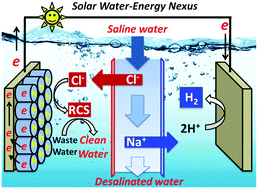当前位置:
X-MOL 学术
›
Energy Environ. Sci.
›
论文详情
Our official English website, www.x-mol.net, welcomes your
feedback! (Note: you will need to create a separate account there.)
Solar desalination coupled with water remediation and molecular hydrogen production: a novel solar water-energy nexus†
Energy & Environmental Science ( IF 32.4 ) Pub Date : 2017-11-28 00:00:00 , DOI: 10.1039/c7ee02640d Seonghun Kim 1, 2, 3, 4 , Guangxia Piao 1, 2, 3, 4 , Dong Suk Han 5, 6, 7, 8, 9 , Ho Kyong Shon 10, 11, 12, 13, 14 , Hyunwoong Park 1, 2, 3, 4
Energy & Environmental Science ( IF 32.4 ) Pub Date : 2017-11-28 00:00:00 , DOI: 10.1039/c7ee02640d Seonghun Kim 1, 2, 3, 4 , Guangxia Piao 1, 2, 3, 4 , Dong Suk Han 5, 6, 7, 8, 9 , Ho Kyong Shon 10, 11, 12, 13, 14 , Hyunwoong Park 1, 2, 3, 4
Affiliation

|
A novel sunlight-water-energy nexus technology is presented that combines the photoelectrocatalytic (PEC) desalination of saline water and desalination-driven wastewater remediation coupled with the production of molecular hydrogen (H2) from water. To accomplish this, morphologically tailored TiO2 nanorod (TNR) and hydrogen-treated TNR (H-TNR) array photoanodes are placed in an anode cell and Pt foils are located in a cathode cell, while a middle cell containing saline water (0.17 M NaCl) faces these cells through anion and cation exchange membranes, respectively. Upon irradiation by simulated sunlight (AM 1.5G, 100 mW cm−2), the photogeneration of charge carriers initiates the transport of chloride and sodium in the middle cell to the anode and cathode cells, respectively, leading to the desalination of saline water. The chloride in the anode cell is converted to reactive chlorine species (RCS), which effectively decompose urea to N2 as a primary product (>80%), while the sodium in the cathode cell accelerates the H2 production from water with a Faradaic efficiency of ∼80%. The PEC performance of the H-TNR photoanodes is superior to that of the TNR in the anodic and cathodic processes because of the reduced charge transfer resistance and sub-nanosecond charge transfer kinetics (∼0.19 ns), leading to a specific energy consumption of 4.4 kW h m−3 for 50% desalination, with an energy recovery of ∼0.8 kW h m−3. The hybrid system is found to operate for a period of ∼60 h with natural seawater, and virtually all the photoanodes are shown to be capable of driving the hybrid process. Although tested as a proof-of-concept, the present technology opens up a novel field involving a sunlight-water-energy nexus, promising high efficiency desalination and the desalination-driven remediation of water with simultaneous H2 production.
中文翻译:

太阳能淡化与水修复和分子氢产生结合:新型太阳能水能关系†
提出了一种新颖的阳光-水-能量关系技术,该技术结合了盐水的光电催化(PEC)脱盐技术和脱盐驱动的废水修复技术,以及从水中产生分子氢(H 2)的技术。为此,将形态学定制的TiO 2纳米棒(TNR)和经过氢处理的TNR(H-TNR)阵列光阳极置于阳极池中,将Pt箔置于阴极池中,而将含有盐水(0.17 M NaCl)分别通过阴离子和阳离子交换膜面对这些细胞。在模拟阳光照射下(AM 1.5G,100 mW cm -2),电荷载流子的光生化分别引发中间池中的氯化物和钠向阳极和阴极池的运输,从而导致盐水脱盐。阳极电池中的氯化物转化为反应性氯物质(RCS),可有效地将尿素分解为主要产物N 2(> 80%),而阴极电池中的钠则通过法拉第加速了水中H 2的产生。效率约为80%。H-TNR光阳极的PEC性能在阳极和阴极过程中优于TNR,这是因为降低了电荷转移阻力和亚纳秒电荷转移动力学(〜0.19 ns),导致单位能耗为4.4千瓦hm -350%的脱盐率,能量回收约为0.8 kW hm -3。发现该混合系统可在天然海水中运行约60小时,并且实际上所有的光阳极都能够驱动混合过程。尽管作为概念验证进行了测试,但本技术开辟了涉及阳光-水-能量关系的新领域,有望实现高效脱盐和脱盐驱动的水修复,同时生产H 2。
更新日期:2017-11-28
中文翻译:

太阳能淡化与水修复和分子氢产生结合:新型太阳能水能关系†
提出了一种新颖的阳光-水-能量关系技术,该技术结合了盐水的光电催化(PEC)脱盐技术和脱盐驱动的废水修复技术,以及从水中产生分子氢(H 2)的技术。为此,将形态学定制的TiO 2纳米棒(TNR)和经过氢处理的TNR(H-TNR)阵列光阳极置于阳极池中,将Pt箔置于阴极池中,而将含有盐水(0.17 M NaCl)分别通过阴离子和阳离子交换膜面对这些细胞。在模拟阳光照射下(AM 1.5G,100 mW cm -2),电荷载流子的光生化分别引发中间池中的氯化物和钠向阳极和阴极池的运输,从而导致盐水脱盐。阳极电池中的氯化物转化为反应性氯物质(RCS),可有效地将尿素分解为主要产物N 2(> 80%),而阴极电池中的钠则通过法拉第加速了水中H 2的产生。效率约为80%。H-TNR光阳极的PEC性能在阳极和阴极过程中优于TNR,这是因为降低了电荷转移阻力和亚纳秒电荷转移动力学(〜0.19 ns),导致单位能耗为4.4千瓦hm -350%的脱盐率,能量回收约为0.8 kW hm -3。发现该混合系统可在天然海水中运行约60小时,并且实际上所有的光阳极都能够驱动混合过程。尽管作为概念验证进行了测试,但本技术开辟了涉及阳光-水-能量关系的新领域,有望实现高效脱盐和脱盐驱动的水修复,同时生产H 2。











































 京公网安备 11010802027423号
京公网安备 11010802027423号